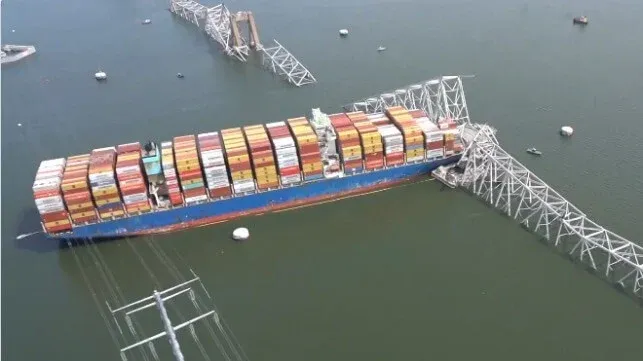US Files $103M Claim Alleging Dali Was "Unseaworthy" and "Jury-Rigged"

The U.S. Department of Justice (DOJ) has filed a $103 million civil claim against Grace Ocean and Synergy Marine, the owners and operators of the containership Dali.
The DOJ’s filing in U.S. District Court presents one of the most comprehensive and detailed accounts of the incident, asserting that the Dali was knowingly kept in service despite being in an "unseaworthy" condition, with the ship's systems being "jury-rigged" to keep it operational.
These makeshift repairs, according to the DOJ, were directly responsible for the chain of failures that culminated in the fatal incident, making it an entirely preventable disaster.
A Preventable Tragedy: Gross Negligence and Safety Violations
At the heart of the DOJ's case is the allegation that Grace Ocean and Synergy Marine were fully aware of serious, long-standing technical issues with the Dali, particularly related to its mechanical and electrical systems. Instead of addressing these problems in accordance with maritime safety standards, the companies are accused of taking shortcuts to save money.
This gross negligence, the DOJ claims, made the Dali a ticking time bomb on the high seas, endangering both the crew and anyone near its path.
Principal Deputy Assistant Attorney General Brian M. Boynton, head of the DOJ's Civil Division, stated, “This was an avoidable catastrophe, resulting from a series of reckless decisions made by the owner and operator of the Dali. They knowingly sent the vessel to sea in a highly compromised state, prioritizing cost savings over safety.”
According to the DOJ, this vibration had been a known issue for some time and had been improperly "fixed" with makeshift solutions, including welding a cargo hook between the transformer and a nearby steel beam. This temporary solution, or "jury-rigging," did not resolve the underlying problem and ultimately led to a catastrophic chain of events.

The Engineering Failures that Led to Disaster
The incident occurred as the Dali was departing Baltimore Harbor, during which the primary electrical transformer experienced a failure due to vibration issues. The transformer, retrofitted with anti-vibration braces, had been cracking repeatedly, and rather than replace or properly repair it, the ship's engineers welded the cracks, making temporary repairs that only exacerbated the situation.
On the day of the disaster, this faulty transformer tripped, cutting off power to the vessel as it navigated out of the harbor. According to the DOJ, the automated backup system, which should have restored power, had been manually disabled by the crew in previous operations.
As a result, the crew was left scrambling in the dark to manually reset the systems, in clear violation of SOLAS (Safety of Life at Sea) regulations. The emergency generator, which should have started immediately, took over a minute to engage—far longer than the required time.
Even when power was restored, it failed again due to a faulty fuel pump that had been installed to save money. The DOJ claims that this pump was not designed to function during a recovery from a blackout, and its malfunction caused a second blackout. Without adequate fuel pressure, the ship was left powerless in a critical moment.
Bridge Crew’s Struggle to Avert the Allision
As the Dali drifted powerless towards the Francis Scott Key Bridge, the crew and the ship’s pilot made a series of desperate attempts to regain control. The pilot ordered the port anchor to be dropped to slow the vessel’s advance, but the crew was unable to comply because the anchor was not ready for immediate release, as required by maritime safety regulations. Next, the pilot attempted to use the ship’s bow thruster to steer it away from the bridge, but this critical piece of equipment was also unavailable due to prior maintenance issues.
The Dali itself sustained significant damage, and debris from the incident blocked a major shipping channel, halting maritime traffic in and out of Baltimore Harbor.
Investigations and Evidence of "Jury-Rigging"
The DOJ’s investigation revealed extensive evidence of cost-cutting measures and improper repairs that compromised the vessel’s safety. During their inspection, investigators found that the crew had attempted to reduce the vibrations by welding a metal cargo hook between the transformer and a steel beam. This crude solution only exacerbated the underlying problem and contributed to the transformer failure that triggered the blackout.
Further evidence of negligence was uncovered during the DOJ's inspection of the ship after the incident. Investigators found loose bolts, broken electrical cable ties, and cracked braces at the transformer and switchboard, all indicating that the ship’s electrical systems were in a state of disrepair. The condition was so hazardous that the inspection was discontinued due to safety concerns.
In addition to the DOJ’s findings, the U.S. Coast Guard joined the investigation and supported the claims of gross negligence. Rear Admiral Laura M. Dickey, Deputy for Operations Capability and Policy of the U.S. Coast Guard, stated, “Wholly preventable failures by the owner and operator of the Dali caused this tragic incident. They failed to comply with basic safety regulations and allowed a dangerous vessel to remain in service.”
The crew’s failure to report previous blackouts to the U.S. Coast Guard, as required by law, was another critical oversight highlighted in the DOJ’s case. By neglecting to disclose these incidents, the ship’s owners and operators concealed the extent of the problems from regulatory authorities, further endangering the lives of the crew and those in the vessel’s vicinity.
Financial Impact and Legal Consequences
The DOJ’s claim seeks to recover more than $103 million in costs related to the disaster, including the removal of approximately 50,000 tons of steel, concrete, and asphalt from the wreckage, as well as the efforts to clear the Dali from the channel and reopen the harbor.
The breakdown of costs includes $74 million for the U.S. Army Corps of Engineers, $22 million for the U.S. Coast Guard, $3.5 million for the Department of Labor, $1.8 million for the U.S. Navy, and $830,000 for the Maritime Administration (MARAD).
In addition to these costs, the DOJ is seeking punitive damages to deter other ship operators from engaging in similar cost-cutting measures that jeopardise safety. The State of Maryland, which owns the bridge, is expected to file its own lawsuit to recover the costs of rebuilding the destroyed section of the bridge, a claim that could potentially exceed the federal claim in financial scope.
Broader Legal Ramifications
Grace Ocean and Synergy Marine have attempted to limit their liability to $44 million by invoking an antiquated maritime law. However, in response to this effort, the DOJ is pushing for changes in U.S. law to ensure that international shipping companies can be held fully accountable for the damages they cause.
The civil lawsuit is only one aspect of the legal proceedings. The families of the six victims have also filed their own lawsuits, and local businesses in Baltimore have sought compensation for the economic losses caused by the closure of the shipping channel.
In addition to the civil cases, the FBI is conducting a criminal investigation, which could lead to further charges. The National Transportation Safety Board (NTSB) is also involved, and while their full report is not expected for up to a year, preliminary findings from an April inspection noted that some of the ship’s systems were functioning.
Conclusion
The Dali disaster serves as a stark reminder of the dangers posed by cost-cutting and negligent practices in the shipping industry. The DOJ’s $103 million lawsuit against Grace Ocean and Synergy Marine is a significant legal action aimed at holding the ship’s owners and operators accountable for their reckless disregard for safety.
The outcome of this case will likely have far-reaching implications for maritime safety regulations and the future accountability of international shipping companies. As the investigation continues and more evidence is uncovered, the scope of the legal and financial repercussions for those responsible will likely increase.